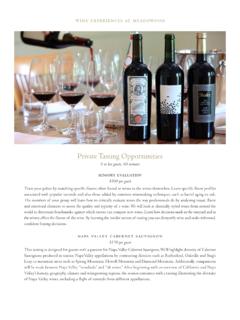Transcription of Fermentation Products - ENCYCLOPEDIA OF LIFE SUPPORT ...
1 CHEMICAL ENGINEEERING AND CHEMICAL PROCESS TECHNOLOGY Vol. V - Fermentation Products - K. Chojnacka Fermentation Products . K. Chojnacka Institute of Inorganic Technology and Mineral Fertilizers, Wroc aw University of Technology, Poland Keywords: Fermentation , food Products , chemicals, pharmaceuticals, feeds, lactic acid, ethanol, bacteria, yeast, molds, fungi, chemical engineering Contents 1. Introduction Definition TE SS. History Theory S. Benefits and Pitfalls of Fermentation R. Effect on Foods AP L. 2. Fermentation feedstocks H O. Microorganisms Nutrient Sources C E. Equipment and Conditions of Fermentation 3. Food Fermentation Products E O . Milk Products Curdled Milk Sour Cream Yogurt PL C. Kefir Koumiss M ES. Cheese Vegetables Sauerkraut SA N. Pickles Olives U. Starchy Plant Foods Cereals, Tubers and Roots Cereals Roots and Tubers Breadmaking Proteinaceous Leguminous Seeds and Oil Seeds Soy Products Nuts Cocoa and Coffee Meat and Fish Products Meat Fish Alcoholic Beverages Fermented, not-distilled Fermented, distilled Vinegar and Other Food Acids ENCYCLOPEDIA of Life SUPPORT Systems (EOLSS).
2 CHEMICAL ENGINEEERING AND CHEMICAL PROCESS TECHNOLOGY Vol. V - Fermentation Products - K. Chojnacka Vinegar Citric Acid Tartaric Acid Fumaric Acid Lactic Acid Oils 4. Chemicals and pharmaceuticals made by Fermentation Ethanol Other than Ethanol Industrial Alcohols Industrial Enzymes Pharmaceuticals Produced by Direct Fermentation Produced by Biotransformation TE SS. Vitamins Biopolymers S. Flavor Modifiers R. Monosodium Glutamate (MSG). AP L. Maltol and ethyl Maltol H O. Secondary Metabolites 5. Fermentation Products in feed and agriculture C E. Silage Microbial Pesticides E O . Single Cell Protein (SCP). 6. Recent developments and future trends Glossary Bibliography PL C. Biographical Sketch M ES. Summary Fermentation was traditionally a process which enabled to preserve food and as such SA N. has been used for centuries until present. However nowadays, the main purpose of food Fermentation is not to preserve, since other preservation techniques are known, but to U.
3 Produce a wide variety of Fermentation Products with specific taste, flavor, aroma and texture. Using various microbial strains, Fermentation conditions (microorganisms, substrates, temperature, time of Fermentation etc.) and chemical engineering achievements, enable us to manufacture hundreds of types of dairy (cheeses, fermented milk Products ), vegetable (sauerkraut, pickles, olives), meat (fermented sausages). Products , breads, alcoholic beverages (wine, beer, cider), vinegar and other food acids, as well as oils. In such a wide variety of Products , tastes and textures, surprising is that in the majority of cases, only two types of fermentations are used: lactic acid and ethanolic Fermentation . The function of both is to change conditions, so unwanted spoiling or pathogenic microorganisms would not grow and alter the food. Historically, Fermentation Products were mainly food Products , but in recent years an increased interest has been observed in the production of bulk chemicals (ethanol and other solvents), specialty chemicals (pharmaceuticals, industrial enzymes), biofuels and food additives (flavor modifiers).
4 Fermentation processes are also used in agriculture. ENCYCLOPEDIA of Life SUPPORT Systems (EOLSS). CHEMICAL ENGINEEERING AND CHEMICAL PROCESS TECHNOLOGY Vol. V - Fermentation Products - K. Chojnacka The Products are diversified: from traditionally made silages, through single cell protein, ending with microbial pesticides. 1. Introduction Fermentation Products include: food Products : from milk (yogurt, kefir, fresh and ripened cheeses), fruits (wine, vinegar), vegetables (pickles, sauerkraut, soy sauce), meat (fermented sausages: salami). industrial chemicals (solvents: acetone, butanol, ethanol; enzymes; amino acids). specialty chemicals (vitamins, pharmaceuticals). Microbial fermentations can be either homofermentative single main product, or heterofermentative mixed Products . The main Fermentation Products include organic TE SS. acids, ethyl alcohol and carbon dioxide. Commercially the mostly important are lactic S.
5 Acid and ethanolic fermentations. Lactic acid Fermentation is used in Fermentation of R. milk, vegetables (cucumber, cabbage, cassava), cereals (wheat, maize), meat and fish. In AP L. milk and meat fermentations, starters are necessary, in other natural flora is sufficient. H O. Alcoholic Fermentation is one of the most important and the oldest processes. It is used in the production of alcoholic beverages, chemical and automotive industry, solvents C E. and starting materials for the manufacture of cosmetics and pharmaceuticals, as well as disinfectants in medicine. E O . Definition The term Fermentation comes from a Latin word fermentum (to ferment). The PL C. historical definition describes Fermentation as the process in which chemical changes in an organic substrate occur as the result of action of microbial enzymes. Fermentation M ES. can be described as respiration without air.
6 Historically, the science of Fermentation is called zymology and the first zymologist was Louis Pasteur, who as the first made yeast responsible for Fermentation . Alchemy called Fermentation putrefaction natural rotting SA N. or decomposing of substances. Nowadays, it is a metabolic process in which carbohydrates and related compounds are partially oxidized with the release of energy U. in the absence of any external electron acceptors organic compounds produced by breakdown of carbohydrates. During Fermentation , incomplete oxidation of organic compounds occurs and for this reason less energy is obtained when compared with aerobic oxidation of the compound. Paradoxically, the term industrial Fermentation usually refers to either aerobic or anaerobic processes, whereas Fermentation in biochemical context describes a strictly anaerobic process, which occurs if pyruvic acid does not enter the Krebs cycle and if electrons from glucose metabolism do not enter electron transport system.
7 In this process, reduced organic compounds are formed, usually acid by- Products . Industrial Fermentation , a term used in chemical engineering, describes the process operations that utilize a chemical change induced by a living organism or enzyme, in particular bacteria, yeast, molds or fungi which produce a specified product. History ENCYCLOPEDIA of Life SUPPORT Systems (EOLSS). CHEMICAL ENGINEEERING AND CHEMICAL PROCESS TECHNOLOGY Vol. V - Fermentation Products - K. Chojnacka Fermentation of food arose more by accident than by guided efforts. Fermentation has been used since ancient times to conserve and alter foods. For thousand of years Fermentation processes were carried out without understanding microbial mechanisms, until XIX century. Fruit Fermentation is a natural process and in this context Fermentation precedes human history. Greeks even attributed Fermentation to one of gods Dionysos a god of fruit fermentations.
8 The first fermentations included the production of beer (Babylonia), soy sauce (Japan, China), fermented milk beverages (Balkans and Central Asia) (Table 1). Fermented beverages appeared in 5000 in Babylon, 3150 in Ancient Egypt, 2000 in Mexico and 1500 in Sudan. Before World War I the only large-scale Fermentation product was ethanol. During World War I, acetone-butanol Fermentation was commercially established. Acetone was TE SS. used in explosives production. Shortly after the war, sharp increase in the market of Fermentation Products was observed manufacture of organic acids began. Before S. World War II Fermentation was mainly a method of food production. In the years 1941- R. 46, the market for conventional Fermentation Products , such as antibiotics, germ AP L. warfare, was established. This greatly increased interest in industrial utilization of H O. microorganisms. C E.
9 Time Fermentation Product Place Ref. Antiquity Bread, vinegar, soy sauce, wine, beer 1. E O . 7000 Beer and wine Assyria, Caucasia, 2. Mesopotamia, Sumer 6000 Winemaking Georgia 3. PL C. 5000 Wine jars Zagros Mountains, 3. Iran M ES. Fermented beverages Babylon 3. 3000 Beer and fermented milk Products Babylon 3, 4. 2600 Bread Egypt 3, 5. SA N. 1000 Say sauce and miso China 5. 600 Cheese Asia 5. U. 500 Preservation of fish and meat 100 Bread Ancient Rome 2. Modern times 1700's Vinegar from fruit pomace 5. Gallic acid 5. 1800's Yeast induce Fermentation Erxleben, Germany 1. 1850's 1) Bacteria produce lactic acid which Louis Pasteur, 1, 6. conserves food France 2) Pasteurization heat treatment to prevent unwanted Fermentation 3) Yeast+grape juice wine beginning of the science of food Fermentation end of Composting 5. 1800's ENCYCLOPEDIA of Life SUPPORT Systems (EOLSS). CHEMICAL ENGINEEERING AND CHEMICAL PROCESS TECHNOLOGY Vol.
10 V - Fermentation Products - K. Chojnacka 1900's Aseptic Fermentation (exclusion of 1. unwanted microorganisms). New fermentations Industrial production of acetone, butanol, 1. butanodiol substrates for rubber production 1930 Discovery of biotechnological method of 1, 5. organic acids production citric and gluconic acid 1940's Industrial production of organic acids 1. 1950's Industrial penicillin production first high- 1, 4, cost and high-tech process. First large-scale 5. production of pharmaceuticals. Penicillin TE SS. was the first antibiotic a medication S. against bacterial infections 1950's- Steroid transformations by fungal spores 5. R. AP L. 60's 1960's Commercial production of amino acids by Japan H O 1. Fermentation ; Production of MSG. (monosodium glutamate, flavor enhancer). C E. 1960's- Mycotoxins, treatment and reuse of wastes 5. 80's (animal, plant and domestic).















